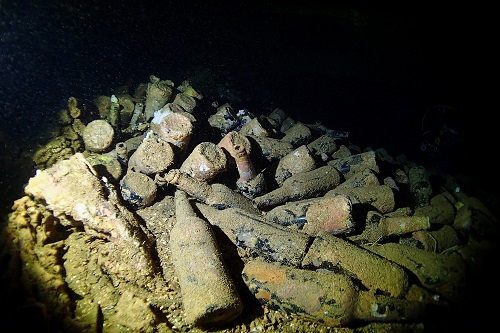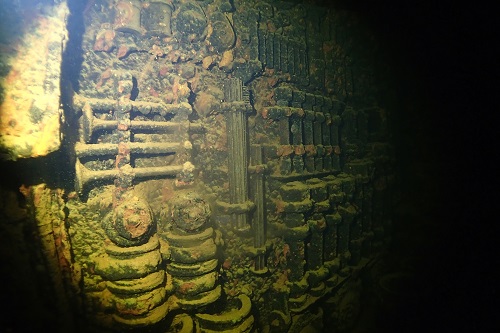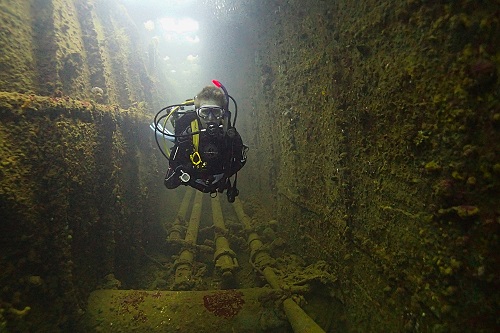With it's heavily defended natural harbour, Chuuk Lagoon was one of Japan's main naval bases during the Pacific War. Dozens of ships passed through these waters providing much needed supplies for the warships, submarines and aircraft deployed throughout the South Pacific. At the first hint of an American attack on Chuuk, the majority of the warships departed, leaving the slower, more cumbersome cargo vessels largely undefended. These sitting ducks made easy targets for the American bombers that decimated the fleet during Operation Hailstone. These cargo ships now rest on the sea bed, packed full of wartime artefacts just waiting for adventurous scuba divers.
Read more about the remains of the Japanese military operation on Weno island.
Beer, Hoki Maru
Holds full of beer bottles are a common sight on the wrecks of Chuuk. They clearly kept the troops well lubricated. Getting into this hold was a tight squeeze though we did find some treasure. Among the jumble of silty bottles, we spotted a sparkling new diamond ring! We were quite excited by our find until we realised it belonged to the honeymooning couple on our boat. They were however delighted to get their ring back.

Crockery, Shinkoku Maru
Decorative ceramics added a touch of luxury to the officers' lives. Finely painted porcelain can be found all over the wrecks of Chuuk Lagoon. We also saw a full range of sake cups, water filters and other crockery.

Deck, Nippo Maru
Many of the wrecks are encrusted in coral and teeming with fish. Black snapper are a common sight on the Nippo Maru. In other areas, whole sections of the ship have been completely hidden under layers of coral reef.

Bathroom, Shinkoku Maru
Most of the bathrooms had tiled Japanese style baths. The smaller sections were filled with hot and cold water. Bathers could scoop this water into the main bath to adjust the water temperature.

Bulldozer, Hoki Maru
This bulldozer was one of many vehicles packed into the Hoki Maru. It would have been used to build new airstrips along with the tractors, trucks and pavement roller on the lower decks. As they are protected inside the wreck, these are some of the best preserved vehicles in Chuuk Lagoon.

Bicycle, Kiyosumi Maru
Among the trucks, tanks, aircraft and numerous other vehicles that we saw on the wrecks, bicycles were probably the most random. We wondered why they bothered since these bicycles would be more or less useless in Chuuk's dense mountainous jungle.

Machine Shop, Kensho Maru
In the bowels of the engine room, we found the cramped machine shop full of tools and machinery. On some wrecks the machine shop is a mess of spare parts and debris but this was certainly not the case on the Kensho Maru. The chief engineer kept his the tools and spares meticulously organised.

Telephone, Heian Maru
This random collection of artefacts, including bottles, plates and even a telephone, is laid out on the hull of the Heian Maru. The local dive guides arrange exhibits like these on many of Chuuk's wrecks. This means there are always interesting things to see on the shallower parts of the dive too.

Periscopes, Heian Maru
The Heian Maru was a submarine tender carrying all manner of supplies to keep the Japanese submarines in working order. The holds are crammed with long lance torpedoes and submarine batteries. Here Maddy was swimming over the spare periscopes stored in one of the companionways.

How To Get To Chuuk Lagoon
Flights to Chuuk are very limited and only operate around 3 times a week.
1. Fly to Tokyo, Osaka, Seoul or Manila.
2. Take a United Airlines flight to Guam and from there on to Chuuk.
Many thanks to the Odyssey liveaboard for their kind hospitality. The level of service on board was exceptional and the rooms were larger than the average hotel room. Captain Mike's in-depth knowledge of the wrecks and his detailed videos made the dive briefings really special too.
